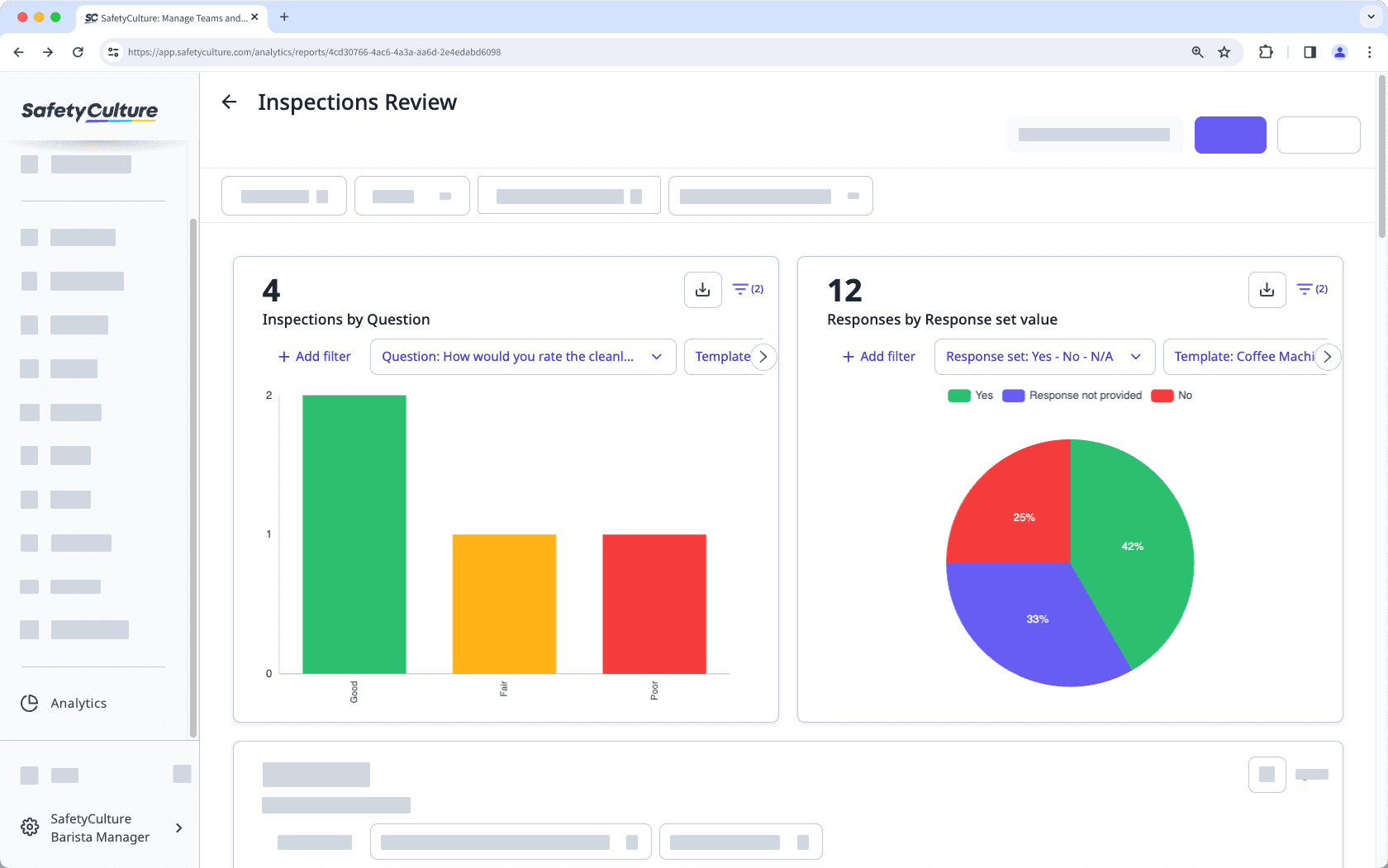Inspektionen in Analysen nach Fragen und Antworten anzeigen
Erfahren Sie, wie Sie Inspektionen anhand von Fragen und Antworten in der Analysefunktion mithilfe der Web-App anzeigen können.Was bedeutet es, Inspektionen nach Fragen und Antworten in den Analysen anzeigen?
Wenn Sie Ihre Inspektionen nach Fragen filtern, können Sie Muster, Trends und verbesserungswürdige Bereiche leicht erkennen. Wenn Sie wissen, wie oft bestimmte Antworten bei Inspektionen ausgewählt werden, können Sie schnell die Bereiche identifizieren, die für Sie von Interesse sind. So können Sie Ihre Bemühungen priorisieren, um die wichtigsten Dinge zuerst anzugehen.

Inspektionen nach einer Frage anzeigen
Wählen Sie
Analysenaus dem Menü auf der linken Seite.
Klicken Sie oben rechts auf der Seite auf
Dashboard erstellen .
Klicken Sie oben links vom Diagramm auf
Messeinheit auswählen und wählen Sie
Messeinheit auswählen aus.
Klicken Sie oben links vom Diagramm auf Attribut auswählen und wählen Sie Attribut auswählen aus.
Klicken Sie auf Frage auswählen und wählen Sie dann aus dem Dropdown-Menü die Vorlage und die Frage aus, die Sie analysieren möchten. Frage auswählen
Klicken Sie auf Fertig.
Klicken Sie auf das Diagrammsymbol oben rechts vom Diagramm und wählen Sie dann den Diagrammtyp aus, den Sie zur Visualisierung der Daten verwenden möchten.
Klicken Sie oben rechts auf der Seite auf Speichern.
Die Gesamtanzahl der Inspektionen im Diagramm spiegelt die Anzahl der Antworten auf die ausgewählte Frage wider. Wenn ein Nutzer beispielsweise „Ja“, „Nein“ und „N/A“ für dieselbe Frage auswählt, wird jede Antwort gezählt, was zu insgesamt 3 Inspektionen führt.
Inspektionen nach einem Antwort-Set anzeigen
Wählen Sie
Analysen in der Seitenleiste oder in
Mehr aus.
Fügen Sie hinzu oder bearbeiten Sie ein bestehendes Diagramm.
Klicken Sie im Drop-down-Menü unter „Metrik“ auf Antworten. Das Attribut wird standardmäßig auf Werte für Antwort-Sets gesetzt.
Wenn Sie ein neues Dashboard erstellen, klicken Sie auf
Messeinheit auswählen und wählen Sie Antworten.
Klicken Sie aufAntwort-Set auswählen und wählen Sie das Antwort-Set, das Sie verwenden möchten.
Klicken Sie im Drop-down-Menü unter „Diagrammtyp“ auf den entsprechenden Diagrammtyp für Ihre Daten.
Klicken Sie oben rechts auf der Seite auf Diagramm speichern, um die Änderungen im Diagramm zu speichern.
Klicken Sie oben rechts auf der Seite auf Speichern, um die Änderungen in Ihrem Dashboard zu speichern.
Wenn Sie ein Standard-Antwort-Set bearbeitet haben und es zum Filtern Ihrer Inspektionsdaten verwenden möchten, empfehlen wir Filtern mit einer bestimmten Vorlage, um sicherzustellen, dass Sie die richtigen Daten erhalten.
Sie können auch den Filter "Frage und Antwort" verwenden, um Ihre Daten weiter einzugrenzen.
Einschränkungen
Sie können Daten nur filtern, indem Sie Standard-Antwort-Sets und globale Antwort-Sets auswählen. Standard-Antwort-Sets werden automatisch hinzugefügt, wenn Sie eine neue Vorlage erstellen. Wenn Sie jedoch Antworten umbenennen, löschen oder neue hinzufügen, werden diese als Zahlenplatzhalter in Diagrammen angezeigt.
Das Attribut „Frage“ unterstützt nur Multiple-Choice-Fragen, die benutzerdefinierte Antwort-Sets und globale Antwort-Sets enthalten.
Diagramme mit mehreren ausgewählten Messwerten können das Attribut „Frage“ nicht verwenden.
Häufig gestellte Fragen
„Frage nicht gefunden“ bedeutet, dass die Frage aus der Vorlage gelöscht wurde. Bitte beachten Sie, dass das Löschen einer Frage und das anschließende erneute Erstellen derselben Frage sie in keiner Weise mit der vorherigen Version verknüpft.
Zahlenplatzhalter wie [1], [2] und so weiter bedeuten, dass die Antwort entweder neu hinzugefügt, umbenannt oder aus der Vorlage gelöscht wurde.
War diese Seite hilfreich?
Vielen Dank für Ihre Anmerkungen.